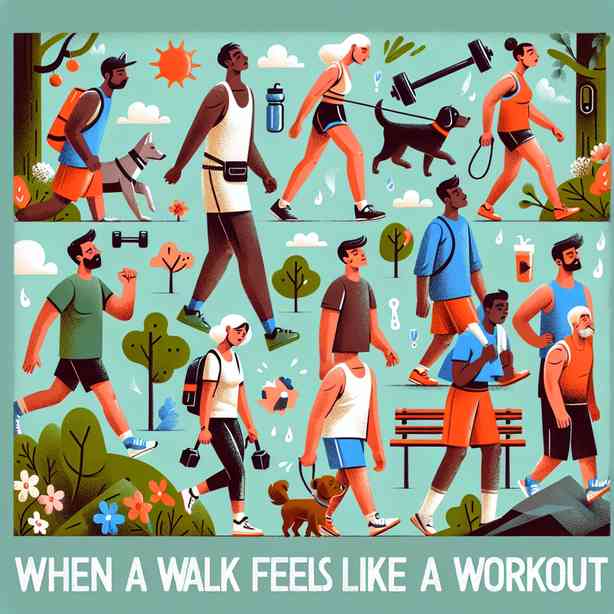
Walking is one of the simplest forms of exercise, yet many people underestimate its potential as a workout. When we think of workouts, we often envision rigorous activities like running, weightlifting, or cycling. However, a walk can be a powerful workout if done correctly, and it can offer immense benefits for both physical and mental health. In this piece, we will delve into how a walk can transform into an effective workout, exploring techniques, duration, intensity, and the overall impact on our well-being.
To begin with, it’s essential to understand the fundamental benefits that walking provides. A brisk walk is a low-impact cardiovascular exercise that can improve heart health, enhance lung capacity, and promote better circulation. Additionally, walking helps in maintaining a healthy weight and can be an effective way to manage stress. Research indicates that even moderate walks, when performed regularly, can significantly reduce the risk of chronic diseases such as diabetes, heart disease, and certain cancers. Thus, incorporating a walking routine into your lifestyle can lead to profound health benefits.
Now, let’s discuss how to elevate your walking session from a leisurely stroll to a workout that challenges your body. The key components to consider include pace, duration, form, and terrain. First, increasing your pace is one of the simplest yet most effective ways to enhance your walking workout. Engaging in brisk walking, which means walking at a pace of about 3 to 4 miles per hour, can elevate your heart rate and increase calorie burn. It’s advisable to maintain a pace where a conversation is possible but requires some effort. This balance keeps the workout challenging while still enjoyable.
Duration is another critical factor. The general recommendation for adults is to aim for at least 150 minutes of moderate aerobic activity each week, which can be broken down into 30 minutes a day, five days a week. Setting a duration goal for your walks will not only help you stay consistent but also allow you to gradually build your stamina. If you’re starting, you may begin with shorter walks and progressively increase your time as your fitness level improves. It’s essential to listen to your body and adjust your goals accordingly.
Form plays a vital role in maximizing the workout benefits of walking. Maintaining proper posture is crucial; ensure your head is up, shoulders are relaxed, and arms are swinging naturally by your sides. Engaging your core muscles while walking can also enhance muscle tone and stability. Make sure to wear comfortable walking shoes to support your feet and prevent injuries. Proper footwear helps in maintaining optimal biomechanics during your walk, thereby enabling you to walk longer distances comfortably.
Incorporating varying terrains and environments into your walking routine can also add an element of challenge and excitement. Walking on different surfaces, such as hills, trails, or sand, can engage various muscle groups and improve overall strength. For instance, uphill walking or hiking can elevate the intensity of your workout significantly, effectively engaging your glutes, hamstrings, and calves. Walking on uneven terrain can enhance balance and coordination, adding a functional aspect to your walking workouts.
Another way to turn your walks into workouts is by incorporating intervals. Walking intervals involve alternating periods of brisk walking with slower-paced recovery walks. For example, you might walk briskly for two minutes, followed by one minute of slower walking. This technique can significantly boost your aerobic capacity and calorie expenditure. Interval walking can be an excellent way to challenge yourself without the need for equipment or a gym.
Moreover, adding resistance to your walking workout can further increase its intensity. You might consider carrying light handheld weights, wearing a weighted vest, or using resistance bands. These additions can help tone your muscles while you walk, enhancing the overall effectiveness of your workout. However, be cautious; it’s essential to start with lighter weights to avoid straining your muscles and joints.
Mental engagement during walks can also amplify the overall experience, making it feel more like a structured workout rather than a casual stroll. Listening to music, audiobooks, or podcasts can make your walks enjoyable and encourage you to keep moving for a longer duration. Furthermore, setting personal goals and tracking your progress can provide motivation and accountability. Numerous apps and fitness trackers are available to help monitor distances, time, and calories burned, making it easier to stay motivated on your walking journey.
Socializing while walking is another effective way to enhance the workout experience. Joining a walking group or pairing up with a friend can make your walks more pleasurable while introducing a layer of commitment. Exercising with others often boosts motivation and can encourage you to push your limits. Plus, engaging in conversation during your walks can make the time fly by while you reap the physical benefits.
To fully appreciate walking as a workout, it’s also essential to factor in recovery and nutrition. After a good walk, your muscles may need time to recover, so incorporating stretching exercises can help alleviate tension and enhance flexibility. A balanced post-walk snack that includes carbohydrates and protein can aid in recovery and replenish lost energy. Remember that hydration is vital, too; drinking water before, during, and after your walks helps maintain peak performance and prevents dehydration.
In conclusion, walking can serve as a robust workout when approached with intention and creativity. By incorporating various techniques—such as pacing, duration, terrain, intervals, and resistance—you can transform a simple walk into a challenging workout that benefits your physical health and mental well-being. It’s an accessible and versatile form of exercise that suits various fitness levels and can fit easily into any lifestyle. Embracing walking as a workout not only helps improve your physical fitness but also encourages a deeper connection with your surroundings and promotes mental clarity. So, lace up your shoes, head outside, and watch how a walk can truly feel like a workout.


